Abstract
This study explores the formulation and assessment of a herbal ointment for wound healing, integrating extracts from Tridax procumbens, Neem and Aloevera. Physicochemical parameters, including pH, viscosity, and spreadability, were evaluated alongside stability assessments to ensure formulation quality. Antimicrobial activity against common wound pathogens was tested, revealing significant efficacy. Preliminary findings suggest the ointment's potential in promoting wound healing through these mechanisms. This research underscores the promising role of Tridax procumbens and Neem in herbal formulations for wound management, providing a foundation for further investigation, including in vivo studies to validate efficacy and safety.
Keywords
This study explores the formulation and assessment of a herbal ointment for wound healing, integrating extracts from Tridax procumbens, Neem and Aloevera. Physicochemical parameters, including pH, viscosity, and spreadability, were evaluated alongside stability assessments to ensure formulation quality. Antimicrobial activity against common wound pathogens was tested, revealing significant efficacy. Preliminary findings suggest the ointment's potential in promoting wound healing through these mechanisms. This research underscores the promising role of Tridax procumbens and Neem in herbal formulations for wound management, providing a foundation for further investigation, including in vivo studies to validate efficacy and safety.
Introduction
The term herbal medicine, which is also known as botanical medicine or phytomedicine, describes the medical application of any plant's seeds, berries, roots, leaves, bark, or flowers. Herbal remedies, which have long been used outside of traditional medicine, are gaining popularity as more recent studies and analyses demonstrate their potential for both illness treatment and prevention. Long before written history began, people employed plants for therapeutic purposes. While some traditional medical systems (such as Ayurveda and Traditional Chinese Medicine) developed herbal remedies as part of a systematic approach, indigenous tribes continued to employ herbs in their healing rituals. Researchers discovered that people planned to employ similar or identical plants for similar reasons across the globe. According to recent estimates from the World Health Organisation, 80% of people globally receive some portion of their basic treatment from herbal medicines. The precise component of most herbs that has a medicinal effect is unknown. Since whole herbs are made up of numerous components, it's likely that these combine to provide the intended therapeutic effect. Herbalists would rather work with whole plants than break them down into their constituent parts. Whole plant extracts are made up of many parts. Together, these elements generate therapeutic effects and reduce the likelihood of any one element causing adverse effects. Herbs are frequently used in combination to increase their efficacy, promote synergistic effects, and lower their toxicity. An important source of novel chemicals with potential utility for the development of chemotherapeutic medicines is traditional medicine. The screening of plants used in popular medicine is the first step towards achieving this goal. Therefore, the goal of antimicrobial research is to find and create new antibacterial and antifungal drugs. Many times, people believe that plant-based medications are less harmful and have less negative effects than synthetic ones. Ointments are another formulation for herbal medications, in addition to other dosage forms. A viscous semisolid preparation used topically to various body surfaces is called an ointment. These consist of the skin as well as the mucous membranes of the nose, eyes, vagina, and anus. An ointment could contain medication or not. Medicated ointments have a dissolved medication in them. [1-3]
Wound Healing Activity:
When the skin is ripped, cut, or punctured, it results in a wound. When an open wound is exposed to air, germs go into it, contaminating it and ultimately causing an infection. This procedure is essentially a response of the connective tissue. This procedure starts with an acute phase of inflammation, which is followed by the production of extracellular macromolecules such as collagen that aid in the creation of scars. To restore the integrity and function of injured tissues, this complex process is triggered in response to an injury. Plants are a reliable source of medicine with few side effects, which is why there is a lot of interest in plant-based medications.
An analysis of the literature shows that traditional plant medicines help with wound healing and a number of skin-related issues. The World Health Organisation (WHO) and our nation have been advocating for the use of traditional medicine due to its affordability, accessibility, and comprehensiveness, particularly in poor nations. Many investigations have been carried out using the extracts of Azardiachta indica (Melinaceae family) and Tridax procumbens L. (Asteraceae family). Herbal medications are also offered in ointment form, a semisolid preparation that is applied topically and utilised as an astringent, emollient, antibacterial, protectant, and antipruritic in addition to other dosage forms. [4,5]
Plants Selected For The Present Study:
In presence study the following plants which have been demonstrated for wound healing activity are selected and were used for the development of herbal formulations.
1.Tridax Procumbence Plant Profile: [2,7,12]
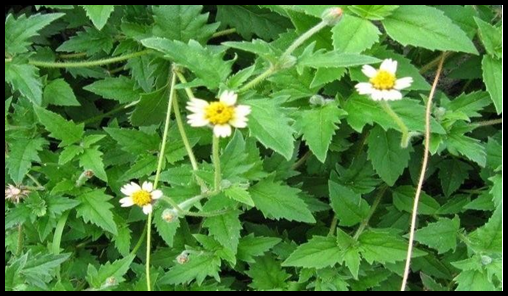
Fig no -1 (Tridax procumbence)
Family: Asteraceae
Synonyms: Ptiloatephium Kunth, Mandonia wedd, Bartolia adans, Batolina adans.
Chemical constituent: alkaloid’s steroids, flavonoids, carotenoids,
Fatty acids, phytosterol, tannin, and minerals.
Taxonomic Classification:
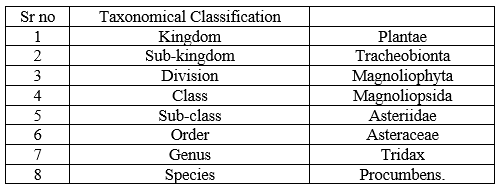
Table 1(a): Taxonomic classification of T. procumbence
Medicinal Uses: Wound healing, Anti-microbial, Anti-inflammatory, Anti-fungal.
Pharmacological Activity of Tridax Procumbence: [13]
- Wound Healing Activity
Wound healing involves a complex interaction between epidermal and dermal cells, the extra cellular matrix, controlled angiogenesis and plasma-derived proteins all coordinated by an array of cytokines and growth factors. Tridax antagonized anti-epithelization and tensile strength depressing effect of dexamethasone (a known healing suppressant agent) without affecting anticontraction and antigranulation action of dexamethasone. Aqueous extract was also effective in increasing lysyl oxidase but to a lesser degree than whole plant extract. Further it has been shown that extract of leaves of this plant also promotes wound healing in both normal and immunocompromised (steroid treated) rats in dead space wound healing model. The plant increase not only lysyl oxidase but also, protein and nucleic acid content in the granulation tissue, probably as a result of increase in glycosamino glycan content.
- Antimicrobial Activity
Whole plant of Tridax has reported for its antimicrobial activity on various species of bacteria. A whole plant is squeezed between the palms of hands to obtain juice. Fresh plant juice is applied twice a day for 3-4 days to cure cuts and wounds. The extract of whole plant of Tridax showed antibacterial activity only against Pseudomonas aeruginosa. The disk diffusion method was used to test the antibacterial activity. Four strains of bacteria employed in test were two-gram positive Bacillus subtilis, Staphylococus aureus and two-gram negative Escherichia coli and Pseudomonas aeruginosa.
- Antidiabetic Activity
The knowledge of diabetes mellitus, as the history revels, existed with the Indians since from prehistoric age. Madhumeha another name of diabetes in which a patient passes sweet urine and exhibits sweetness all over the body in the form of sugar, i.e., in sweat, mucus, urine blood, etc. from ancient time various herbs were practically used for lowering of blood glucose level as such or in juices form. Aqueous and alcoholic extract of leaves of Tridax showed a significant decrease in the blood glucose level in the model of alloxan-induced diabetis in rats.
2. Azadirachta Indica: [11,14]
Azadirachta indica (AI) A. Juss (the neem tree) commomnly known as neem or nimtree, It belongs to the family Meliaceae and it is well known in India and neighboring countries. All parts of the neem tree have been used traditionally for the treatment of numerous ailments for instance bark as an analgesic, alternative, and curative of fever. Various chemical constituents, such as alkaloids, triterpenoids, glycosides, limonoids, flavonoids, fatty acids, and steroids from neem trees have been proven to exhibit anticarcinogenic, anti-inflammatory, antiulcer, antioxidant, immunomodulatory, antifungal, antibacterial, antiviral, antimalarial, antimutagenic, and antihyperglycemic properties.
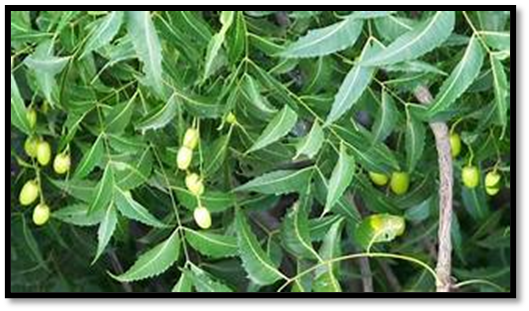
Fig 2: (Azadirachta Indica)
Synonyms: Azadirachta indica, margosa, roseship, melia azadirachta
Chemical constituent: Azadirachitin, salannin, meliantriol, nimbasterol, quercetin, glyceride, oleic acid and stearic acid.
Family: Meliaceae
Taxonomical Classification:
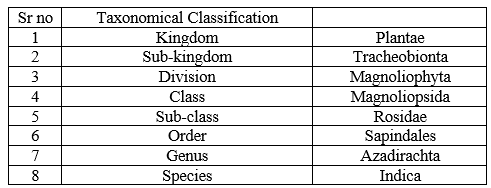
Table 1(b): Taxonomic classification of A.indica
Medicinal Uses: Wound healing, treat acne, treat fungal infection.
Pharmacological Activity: [15]
a) Anti-microbial activity
Whole plant has reported for its antimicrobial activity on various species of bacteria. A whole plant is squeezed between the palms of hands to obtain juice. Fresh plant juice is applied twice a day for 3-4 days to cure cuts and wounds. The extract of whole plant showed antibacterial activity.
b) Anti-oxidant Activity
The production of free radicals at or around the wound may contribute to delay in wound healing through the destruction of lipids, proteins, collagen, proteoglycan and hyaluronic acid. Agents that demonstrate a significant antioxidant activity may, therefore, preserve viable tissue and facilitate wound healing.
c) Anti-inflammatory activity:
Wounds in persistent inflammatory phase may delay the healing process. Preventing prolonged inflammatory phase hasten the healing process.
3. Aloevera: [9,10,16]
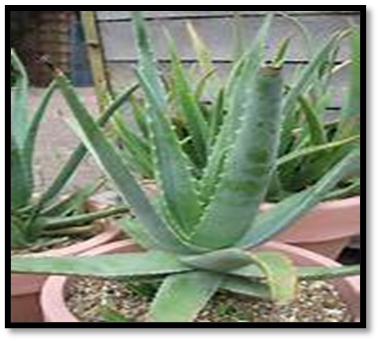
Fig 3: (Aloe vera)
Scientific name: Aloe Barbandesis
Synonyms: Chinese aloe, Cape aloe or Barbados aloe
Chemical constituent: chemical constituents in Aloe vera are Anthraquinones, Aloein, Babandenin, saccharides, prostaglandins, and fatty acids.
Family: Liliaceae.
Taxonomic Classification:

Table 1(c): Taxonomic classification of Aloevera.
Medicinal Uses: Analgesic, Antibacterial, Antiviral, Antifungal, Anti-oxidant immune modulator, Antiseptic, Anti-inflammatory.
MATERIALS AND METHODS
Collection of plant material:
First, we identified and collect the plant leaves 0f tridax procumbens, aloe vera and azadirachta indica from the different localities of vathar and its nearby areas and washed them thoroughly with distilled water. The cleaned plant parts are then allowed for the complete shade drying and then made to a fine powder with a mechanical grinder and stored in an air-tight container.
Prepration of plant extract:
- Tridax Procumbence

Fig 4: Soxhlet Apparatus
Tridax procumbens fresh leaves were gathered and let to dry in the shade for a week. Plant material was dried, then roughly ground and stored in an airtight container. About 100g of plant leaf powder was placed in a soxhlet apparatus and left for 72 hrs, after which the ethanol was extracted at 45 to 55°C. Using a rotary vacuum evaporator, the extracts were gathered and concentrated. A tiny vial was used to gather and preserve the crude semisolid extract. The extract was kept cold, at 4°C, until it was needed for the formulation.
2. Azadirachta Indica
After gathering and properly cleaning the leaves with distilled water, the leaves were allowed to dry in the shade for a period of ten days. Powdered dried leaf material was created. After mixing 150 ml of 90% ethanol into 100 g of powder, it was placed in a percolator and allowed to macerate for seven days, stirring periodically, after being infused with 350 ml of 90% ethanol for three hours. A residue that was blackish-green was obtained by collecting and condensing the ethanolic extract. Airtight containers were used to store the extract in a dark, cold environment.
3. Aloevera:
Raw aloe vera is washed and green portion is completely removed. The transparent sticky mucilage is grinded and used as herbal extract of Aloe vera.
Preliminary phytochemical screening of Azadirachta Indica: [17]
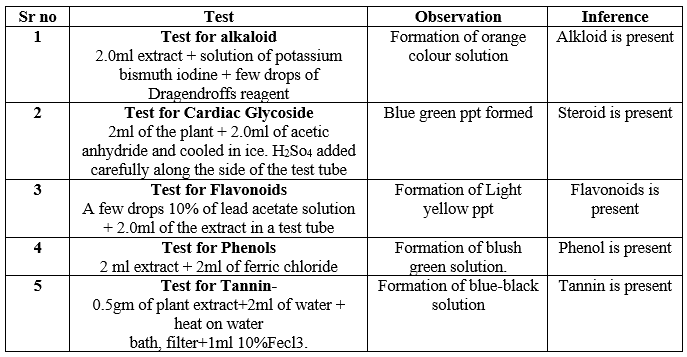
Table 2(a): Preliminary phytochemical screening of Azadirachta Indica.
Preliminary phytochemical screening of Tridax Procumbence: [18]
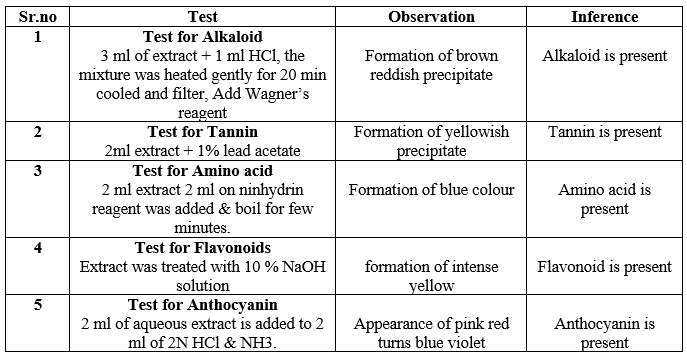
Table 2(b): Preliminary phytochemical screening of T. Procumbence.
Preliminary phytochemical screening of Aloevera: [19]

Table 2(c): Preliminary phytochemical screening of Aloevera.
FORMULATION OF OINTMENT
Procedure for formulation of ointment: [8,20]

Table 3: List of Chemicals used in formulation
The ointment base was first made by precisely weighing wool fat, white soft paraffin, cetostearyl alcohol, and Hard paraffin, then it was put in an evaporating dish over a water bath. After melting, carefully stir to create a homogenous mixture, then cool the basis for the ointment.
In order to create a smooth paste that was two or three times the weight of the base, precisely weighed Neem, Tridax procumbence and Aloevera extract were combined with the base to create a herbal ointment. Additional base was then added gradually to create a homogenous ointment, which was then placed in an appropriate container.
Optimization:

Table 4(a): Quantity of excepients

Table 4(b): Quantity of extract

Fig 5: Formulation of ointment
Evaluation Parameters
1. Sensory evaluation: Physical parameters like color and odor were examined by visual examination.
2. Consistency: Smooth and no greediness is observed.
3. Spreadability: By sandwiching extra sample between two slides that had been squeezed to a uniform thickness using a specific weight for a specific amount of time, the spreadability was ascertained. Spreadability was defined as the amount of time needed to divide the two slides. Better spreadability is the outcome of taking less time to separate two slides.
Spreadability was calculated by the following formula:
S= M×L /T
Where, S- spreadability
M- weight of sample in gram
T-Time taken in seconds
4. Washability: Formulation was applied on the skin and then ease extend of washing with water and checked.
5. Non-irritancy: The formulation prepared was applied to the skin of a human being and observed for the effect.
6. Extrudability: The formation were filled in a collapsible tube container. The Extrudability was determined in terms of the weight of formulation required to extrude o.5 cm of ribbon of ointment in10 sec.
7. Loss on drying: Loss was determined by placing the formulation in a petri dish on an oil bath and drying for the temperature at 105°C.
8. Solubility: Soluble in boiling water, miscible with alcohol, ether, and chloroform.
9. pH: PH of prepared herbal ointment was measured by using a digital pH meter. The solution as ointment was prepared by using 10 ml of distilled water and set aside for 5 min.
RESULT AND DISCUSSION:
A. Preliminary phytochemical test:
a) Test for Azadirachta Indica:

Fig 5: phytochemical test for A. Indica
b) Test for Tridax Procumbence:


Fig 7: Phytochemical test for aloevera.
B. Physicochemical Evaluation of ointment

Table 5: Physicochemical Evaluation of ointment.
CONCLUSION:
In conclusion, the formulation and evaluation of a herbal ointment utilizing Tridax, Neem, and Aloe Vera have shown promising results in enhancing wound healing. Through meticulous formulation and rigorous evaluation, the ointment has demonstrated notable efficacy in accelerating the wound healing process. The synergistic properties of Tridax, Neem, and Aloe Vera have contributed to their combined therapeutic effects, including anti-inflammatory, antimicrobial, and wound-repairing activities. Furthermore, the herbal ointment offers a safe and natural alternative to conventional wound healing agents, potentially minimizing adverse effects commonly associated with synthetic compounds. However, further clinical studies are warranted to validate these findings and explore the ointment's efficacy across different types of wounds and in diverse patient populations. Overall, this research underscores the promising potential of herbal formulations in advancing wound care practices and warrants continued investigation into their therapeutic applications.
REFERENCE
- Chhetri HP, Yogol NS, Sherchan J, Anupa KC, Mansoor S, Thapa P. Formulation and evaluation of antimicrobial herbal ointment. Kathmandu University Journal of Science, Engineering and Technology. 2010;6(1):102-7.
- Udegbunam SO, Nnaji TO, Udegbunam RI, Okafor JC, Agbo I. Evaluation of herbal ointment formulation of Milicia excelsa (Welw) CC berg for wound healing. African journal of Biotechnology. 2013;12(21).
- Jagtap NS, Khadabadi SS, Farooqui IA, Nalamwar VP, Sawarkar HA. Development and evaluation of herbal wound healing formulations. Int J Pharm Tech Res. 2009 Oct;1(4):1104-8.
- Ravindran J, Arumugasamy V, Baskaran A. Wound healing effect of silver nanoparticles from Tridax procumbens leaf extracts on Pangasius hypophthalmus. Wound Medicine. 2019 Dec 1;27(1):100170.
- Maver T, Maver U, Stana Kleinschek K, Smrke DM, Kreft S. A review of herbal medicines in wound healing. International journal of dermatology. 2015 Jul;54(7):740-51.
- Guo SA, DiPietro LA. Factors affecting wound healing. Journal of dental research. 2010 Mar;89(3):219-29.
- Deshmukh R, Agrawal R, Chauragde S, Lilhare S, Mishra MU. Formulation and evaluation of ointment containing natural wound healing activity of Tridax procumbens. Research Journal of Pharmacy and Technology. 2018;11(10):4543-6.
- Jadhav VD, Talele Swati G, Bakliwal Akshada A, Chaudhari GN. Formulation and evaluation of herbal gel containing leaf extract of Tridax Procumbens. J Pharm Biosci. 2015;3:65-72.
- Liang J, Cui L, Li J, Guan S, Zhang K, Li J. Aloe vera: A medicinal plant used in skin wound healing. Tissue Engineering Part B: Reviews. 2021 Oct 1;27(5):455-74.
- Kahramano?lu ?, Chen C, Chen J, Wan C. Chemical constituents, antimicrobial activity, and food preservative characteristics of Aloe vera gel. Agronomy. 2019 Dec 2;9(12):831.
- Rahmani A, Almatroudi A, Alrumaihi F, Khan A. Pharmacological and therapeutic potential of neem (Azadirachta indica). Pharmacognosy Reviews. 2018 Feb 1;12(24):250-5.
- Ingole VV, Mhaske PC, Katade SR. Phytochemistry and pharmacological aspects of Tridax procumbens (L.): a systematic and comprehensive review. Phytomedicine Plus. 2022 Feb 1;2(1):100199.
- Mundada S, Shivhare R. Pharmacology of Tridax procumbens a weed. Int J Pharm Tech Res. 2010 Apr;2(2):1391-4.
- Chundran NK, Husen IR, Rubianti I. Effect of neem leaves extract (Azadirachta indica) on wound healing. Althea Medical Journal. 2015 Jun 30;2(2):199-203.
- Uzzaman S. Pharmacological activities of neem (Azadirachta indica): A review. Int J Pharmacogn Life Sci. 2020;1:38-41.
- Sharma P, Kharkwal AC, Kharkwal H, Abdin MZ, Varma A. A review on pharmacological properties of Aloe vera. Int J Pharm Sci Rev Res. 2014 Nov;29(2):31-7.
- Itelima JU, Nwokedi VC, Ogbonna AI, Nyam MA. Phytochemical screening and antimicrobial activity evaluation of aqueous and ethanolic extracts of the leaf of Azadirachta indica Juss (neem) on some microorganisms.
- Sawant RS, Godghate AG. Preliminary phytochemical analysis of leaves of Tridax procumbens Linn. International Journal of Science, Environment and Technology. 2013;2(3):388-94.
- Al-Wajih AM, El-Shaibany AM, Raweh SM, El–Aasser MM. Preliminary phytochemical screening for various secondary metabolites, quantitative and qualitative analysis of Yemeni Aloe vera and Aloe vacillans flower extracts. GSC Biological and Pharmaceutical Sciences. 2022;21(2):202-10.
- Lokesh Prasad MS, Gurunath KP, Chandrasekar SB, Umashankar C, Pawar AT. Formulation and evaluation of herbal formulations (Ointment, Cream, Gel) containing Tridax procumbens and Areca catachu. Journal of Scientific and Innovative Research. 2017;6(3):97-100.


 Ritika Manjunath Revankar*
Ritika Manjunath Revankar*
 Dr. N. B chougule
Dr. N. B chougule


















 10.5281/zenodo.13219535
10.5281/zenodo.13219535